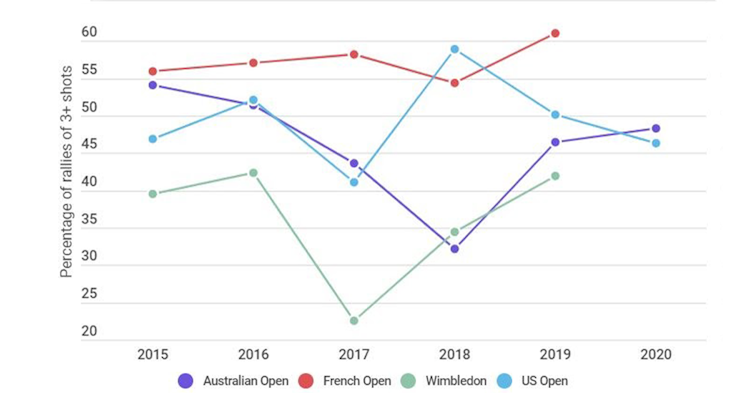Why Is It So Ridiculously Hard To Win On Clay?
Last updated: Jul 7, 2021, 6:37AM | Published: Oct 4, 2020, 11:49PM
103 career titles and 20 Slams leaves little doubt that Roger Federer is one of the greatest tennis players of all time. However, it took a phenomenal effort as well as an early exit of Rafael Nadal in 2009 for 'Fed' to claim his solitary French Open title.
Federer’s great idol, Pete Sampras, never won the French Open. Neither did other tennis legends such as Boris Becker, John McEnroe, Venus Williams, nor Martina Hingis, just to name a few.
Andre Agassi, in his autobiography, stated that winning in Paris was the most difficult achievement of his career, especially since he'd reached the final on two previous occasions before breaking through in 1999, and only after dropping the first two sets.
So what makes it so hard for players to win on the dirt of Roland Garros and on clay in general? Why is the surface so incredibly unforgiving and why does it continually bedevil even some of the very best talents in world tennis?
RELATED: If Nadal And Djokovic Play In Front Of No Fans, Will They Make A Sound?
Firstly, it's an accepted fact that the surface allows a lot more time for players to return their shots. Additionally, while playing on clay, the spin produced by the racket is more intense, thus players are made to run a lot more than they would on any other surface.
The bounce on a clay court is a lot higher than usual as well, which is why we see players stand further away from the baseline than where they would ordinarily stand.
According to a study done by Tennis TV, Nadal’s average forehand top-spin rate in 2018 was nearly 3200 rpm, while his backhand was somewhere between 2400 and 2500 rpm - one of the highest in the business. Returning such shots with such heavy spin and a high bounce over a prolonged period of time is one of the factors that makes 12-time French Open champion Nadal so lethal, and a major reason why he's utterly dominated on the surface since 2005.
For for the sake of context, Novak Djokovic’s average RPM on the forehand is around 2800 rpm and on the backhand is 1800 rpm. Federer's is 2900 on the forehand side and 2500on the backhand.
While a player like Stan Wawrinka doesn't produce much spin on either the forehand or backhand side, his ability to hit through the ball with such immense power is what's made him successful on the surface and where he's collected 7 of his career 16 titles including the 2015 French Open.
RELATED: You Must Be At Least This Tall To Win Regularly On The ATP Tour
Playing on clay involves longer rallies than any other court. If we look at the average number of rallies on a clay court compared to a hard or grass court, the difference is quite staggering.
By comparing Federer’s 2019 semi-finals against Nadal at both the French Open and Wimbledon we can see how profoundly different each contest was. At Roland Garros, 16.5% of their rallies comprised of at least 10shots. When they squared off at Wimbledon just over a month later that number dropped to just 6.9%. Federer is of course someone who usually likes to keep his rallies short, yet he's continually made to work much harder on clay which is why just 10.6% of his total career titles have been won on the surface. In contrast, 70.5% of all Nadal's career titles have been celebrated on clay.
Overall, the number of rallies across professional tennis has reduced over the years. According to the statistics provided by Tennis Abstract, the percentage of the number of rallies over 10 shots in the French Open final in 1978 was 38% compared to 24% in the 2013 French Open final.
This is also due to the fact that rackets were a lot different back then and players were not able to induce much power while striking the ball. While In today’s game, the number of rallies below 5 shots has become more prevalent, the French Open remains a Slam where we still see rallies last much longer than the other three slams.
Longer rallies involve a lot more running, which means more court coverage - something Nadal is known for. An Infosys ATP Beyond The Numbers analysis showed that Nadal covered over 3500 feet in the first set of all his matches between 2018 and 2020, which is almost 1000 feet more than Federer. Interestingly enough though, Federer was the only player from the top-10 who covered more feet in the second set when compared to the first. However, Nadal’s court coverage was streets ahead of the rest of the pack.
RELATED: Better with Age: The Genius Of The Big Three
The combination of top-spin, high bounce, extended rallies, and increased court coverage is what makes winning on clay such an arduous task. The fact Nadal has conquered, and reconquered, the surface repeatedly over the last 15 years only confirms his undeniable greatness.
With this year’s French Open entering its second week, will someone get in between the great Spaniard and his 13th crown? Will Djokovic get his hands on his 2nd Roland Garros title and 18th Slam overall, or will Dominic Thiem carry on his US Open form and confirm his place as 2020’s most successful player?
Did you enjoy this article? Join our free mailing list to get the best content delivered straight to your inbox, or join the conversation by leaving a comment below or on the Stats Insider Twitter or Facebook page.



